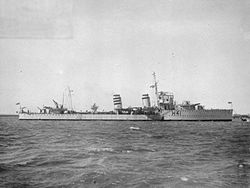HMS Ardent (H41)
|
HMS Ardent
|
||||||||||||||||||||||
|
||||||||||||||||||||||
|
||||||||||||||||||||||
|
||||||||||||||||||||||
|
||||||||||||||||||||||
HMS Ardent (H41) was an A-class destroyer ofthe British Royal Navy that also served in World War II . The destroyer was awarded the Battle Honors "Atlantic 1940", "Norway 1940" and "Scharnhorst action 1940". During the defense of the aircraft carrier Glorious , the Ardent was sunk together with the sister ship Acasta on June 8, 1940 by the German battleships Scharnhorst and Gneisenau .
History of the ship
The ship was launched on June 26, 1929 as part of the Royal Navy's first class of destroyers, which was built after the end of World War I , at Scotts in Greenock . Experience with two previously built prototypes ( Ambuscade and Amazon ) was incorporated into the planning and construction. The new building was the seventh ship of the Royal Navy to bear the name Ardent . The last name was an Acasta class destroyer built by Denny in 1913 , which was sunk on June 1, 1916 in the Battle of the Skagerrak by the German liner Westfalen .
The new destroyer entered service on April 14, 1930.
Ardent formed first together with its sister ships, the third destroyer flotilla that the Mediterranean fleet was assigned. After the outbreak of the Spanish Civil War , the Ardent served with the flotilla in the western Mediterranean from September 1936 to protect British interests and prevent arms deliveries to the warring parties. The ship was last stationed in Barcelona. In 1937 the A-class destroyers were replaced by the new I-class destroyers . The Ardent returned home and was taken out of service on March 14, 1937 to be overhauled in Sheerness . The destroyer received an ASDIC device to track down submarines. After completion of the work, the Ardent was assigned to the local flotilla in Plymouth at the end of April 1938 as a training and alarm destroyer.
War missions
At the beginning of the war, the ship was used in the newly formed 18th Destroyer Flotilla in the English Channel . The tasks included securing convoys in this area, including in particular the troop transports to France .
In April 1940, the destroyer was then used in the attempted defense against the German landing in Norway ( Operation Weser Exercise ) to cover ships of the Home Fleet . When Northern Norway was evacuated because of the German offensive on the western front ( Operation Alphabet ), he and Acasta were supposed to lead the aircraft carrier Glorious back to Scapa Flow , which had taken land planes on board that had previously been stationed in Norway.
On June 8, 1940, the German battleships Scharnhorst and Gneisenau surprised the group west of the Lofoten , despite good visibility , and sank after a two-hour battle ( Operation Juno ). Both destroyers defended the aircraft carrier with full engagement, but ultimately unsuccessfully, through torpedo attacks and the laying of smoke walls. Ardent was the first of the ships to be sunk at position 68 ° 45 ′ N , 4 ° 30 ′ E when trying to allow the aircraft carrier to escape. 152 men of the crew lost their lives. Due to communication problems between the British ships, the crew of the destroyer rescued only two survivors days after the sinking by a German seaplane, one of whom died after a short time.
See also
For other ships of this name see HMS Ardent .
Individual evidence
literature
- John English: Amazon to Ivanhoe: British Standard Destroyers of the 1930s , World Ship Society, Kendal 1993, ISBN 0-905617-64-9
- Norman Friedman: British Destroyers From Earliest Days to the Second World War , Naval Institute Press, Annapolis 2009, ISBN 978-1-59114-081-8
- Geirr H. Haarr: The German Invasion of Norway, April 1940 , Naval Institute Press, Annapolis 2009, ISBN 978-1-59114-310-9
- Geirr H. Haarr: The Battle for Norway: April - June 1940 , Naval Institute Press, Annapolis 2010, ISBN 978-1-59114-051-1
- Michael J. Whitley: Destroyers of World War Two. An international encyclopedia. Arms and Armor Press, London et al. 1988, ISBN 0-85368-910-5 .
